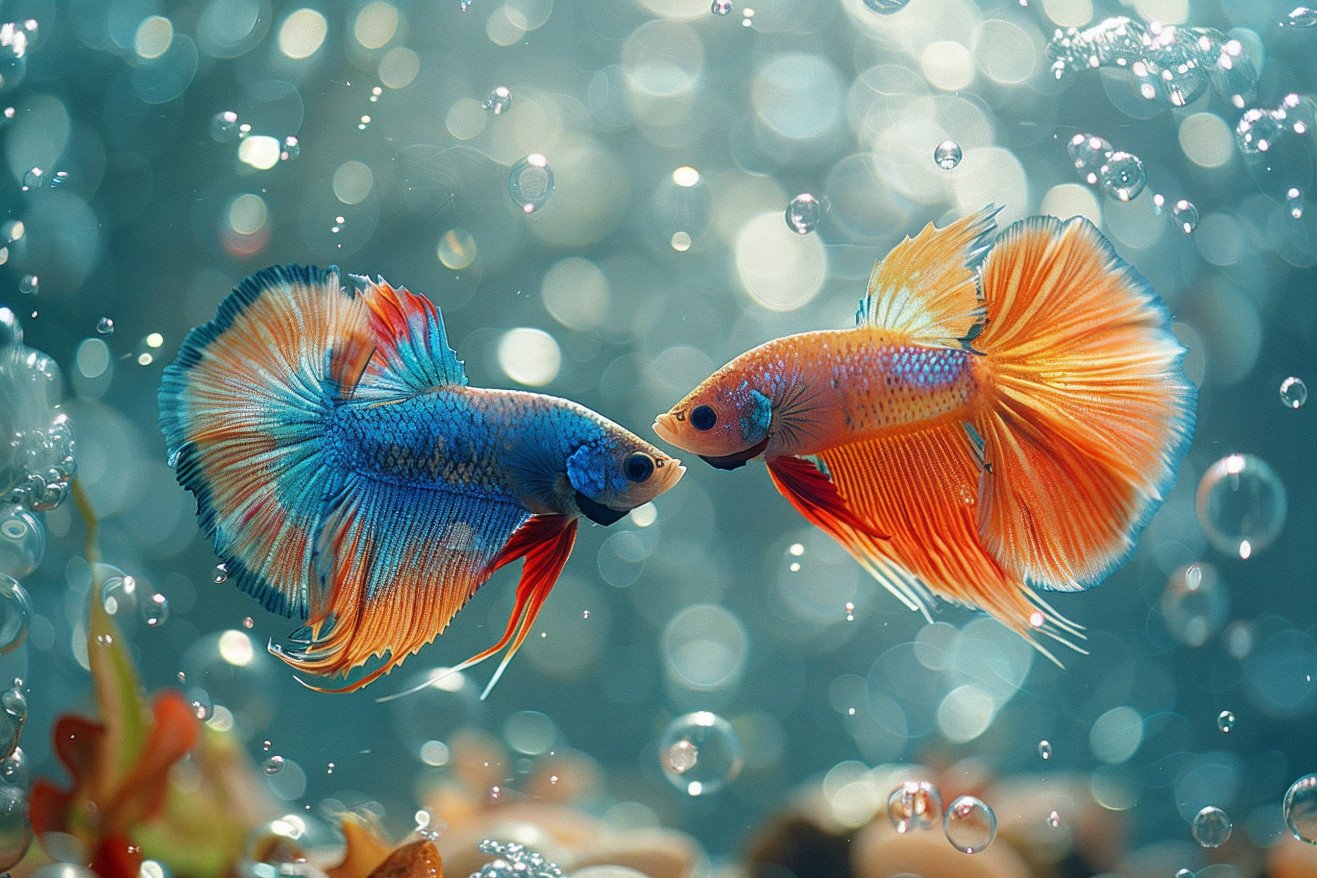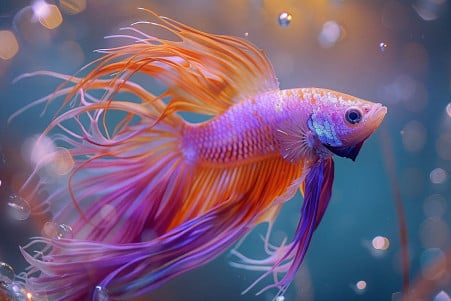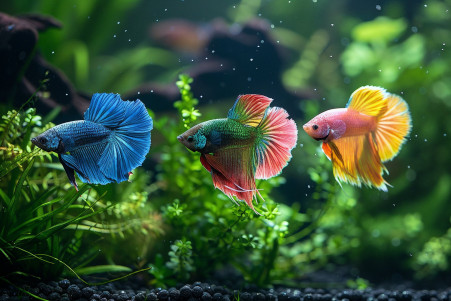Betta Fish Mating: Courtship, Nests, and Reproductive Strategies
25 April 2024 • Updated 25 April 2024

How do these brightly-colored aquarium favorites reproduce – and what fascinating behaviors are involved in betta fish mating? Betta fish reproduction is a fascinating process that involves complex courtship rituals, spawning behaviors, and even parental care by the male in building a bubble nest to hold the eggs.
From the nest-building to the courtship displays, we'll look at scientific research across disciplines like animal behavior, ichthyology, and reproductive biology that sheds light on how these beautiful Siamese fighting fish mate successfully. Delving into mating strategies, environmental factors, and anatomical factors, this in-depth analysis will provide you with a comprehensive understanding of this captivating aspect of betta fish life cycles.
How do betta fish mate?
How to Set Up a Betta Breeding Tank
If you want to successfully breed bettas, you must set up a separate breeding tank. This is because, as the Betta Breeding Forum explains, bettas cannot be bred in their regular tank. This is because the fry need very clean water, which is not possible in a tank that has already been established.
The breeding tank should be at least 10 gallons and can be a clear plastic container or an aquarium. The water should only be 3-4 inches deep. You will also need a submersible heater to keep the water at 80°F, a sponge filter that is powered by an air pump, and live plants, such as Christmas moss and Indian almond leaves. As BettaFishCenter.com points out, Indian almond leaves help lower the pH of the water to slightly acidic, which is necessary for breeding.
In addition to the plants, the tank should also have plenty of hiding places and a place for the male to build a bubble nest. This is where the fertilized eggs will be kept. You can use smooth rocks, Styrofoam cups that have been cut in half, or even tape plants to the side of the tank to help the male build a bubble nest. By setting up a separate, carefully designed breeding tank, you can increase the chances of successful spawning and the health of the fry.
Conditioning the Breeding Pair for Spawning
Conditioning the breeding pair is an important part of successfully breeding bettas. The Modest Fish guide recommends feeding the bettas a high-protein diet of live and frozen foods such as bloodworms, brine shrimp, and California blackworms for 2-4 weeks before breeding. This will help the male and female build up fat stores that will be used during the mating process and while caring for the fry.
It's also important to keep the water clean and the temperature stable at around 80°F during the conditioning period, as Better Bettas explains. It's also important to watch the behavior of the fish. The male should be very active and flaring, and the female should have a slightly protruding ovipositor. The female should also have a rounded belly, which is a sign that she's carrying eggs and is ready to spawn.
Sometimes the male will show signs of aggression, which can make it difficult for the pair to spawn. The Better Bettas guide suggests several ways to deal with a male that's too aggressive or territorial, including limiting the male's contact with the female, introducing a rival male, and providing the female with hiding spots.
How to Care for Betta Fry: Water Changes and Feeding
Caring for betta fish fry is all about keeping up with water changes and making sure the fry are fed. Per the suggestions on NiceBettaThailand.com, frequent and large water changes are necessary for the best possible growth. The site suggests changing 50-100% of the water every day to remove the fry's growth-inhibiting hormones.
Feeding the fry is also important, and they should be fed several times a day with meals that are high in protein, like infusoria and baby brine shrimp. As explained on BeautifulBettas.wordpress.com, these small first foods are necessary for the fry's growth. As the fry get bigger, they can be fed larger foods like crushed flakes and pellets.
Water quality is important for the fry's fast growth. Per NiceBettaThailand.com, it's also important to make sure the water temperature stays between 75-80°F with a heater. However, with regular water changes, careful feeding, and a clean environment, betta lovers can help their fry grow.
Potential Problems and Pitfalls of Betta Breeding
While breeding betta fish can be a rewarding experience, it’s not without its pitfalls. The Betta Fish Forum explains that one of the most common problems is the male’s aggression. If the male is too territorial or aggressive, he may stress or injure the female, which will prevent the pair from successfully spawning. To help reduce the likelihood of this happening, you can use techniques like the separation method, introducing a rival male, and providing the female with hiding places.
In addition to aggression, the breeding pair and their offspring may be affected by a variety of health issues and diseases. PetHelpful lists several common betta fish diseases, including fungal, parasitic, and bacterial infections, that can impact the breeding pair and their fry. To keep these issues at bay, it’s important to make sure the tank water is clean and to quarantine any new fish before adding them to the tank to prevent the spread of disease.
The offspring may also experience genetic abnormalities and deformities, as the Betta Fish Forum points out. Catching and dealing with these issues early is important because there are no treatments for many of these problems. However, you can help reduce the likelihood of these issues by making sure the tank is set up properly, the water is at the right parameters, and by practicing selective breeding.
Ethics of Breeding Betta Fish
Responsible breeding takes time, effort, and careful consideration. The Betta Breeding Forum notes that using high-quality stock from reputable breeders is the only way to guarantee healthy offspring. This is because pet store bettas are mass bred with unknown genetics and are not as healthy or strong as those from professional breeders.
Another important factor is being willing to cull deformed or low-quality fry, which is a requirement according to the Betta Fish Forum. All professional breeders cull to maintain the health and strength of their lines. It's also important to have a clear goal in mind for your breeding program, whether that's focused on color, form, or another characteristic.
Finally, it's important to adhere to industry standards and ethics, as set forth by the International Betta Congress. This includes not misrepresenting bettas when selling or trading them, and only breeding and showing fish that you have personally raised. In short, responsible betta breeding requires a lot of time, effort, and planning, as well as a commitment to the species' well-being.
The Betta Breeding Timeline: From Eggs to Free-Swimming Fry
Once the bettas have successfully spawned, the male betta will take over the important job of tending to the fertilized eggs in the bubble nest he built. Per Beautiful Bettas, the male will stay almost completely still below the nest, fanning the eggs to make sure the water is circulating and that fungus doesn't grow. The eggs will usually hatch within 36-48 hours, depending on the water temperature.
When the eggs hatch, the fry will sink to the bottom of the tank. Per Freshwater Fish Global, the male betta will frantically try to scoop them up and put them back in the bubble nest. Within 12 hours, the fry will have absorbed enough of their yolk sacs to attach themselves to the glass or the bubble nest vertically.
After 2-3 days, the fry will become free-swimming, which means they will be swimming horizontally instead of vertically. Per Beautiful Bettas, once most of the fry are free-swimming, the male can be removed (with caution) to avoid any potential aggression toward the fry.
Conclusion: The Rewarding Journey of Betta Fish Breeding
Breeding betta fish is a fascinating and rewarding process. Proper preparation, tank setup, and care are essential for success. Understanding the courtship rituals, spawning behaviors, and fry development is key.
Responsible breeding practices and ethical considerations must be prioritized. With patience and dedication, betta enthusiasts can experience the joy of raising these vibrant fish.


